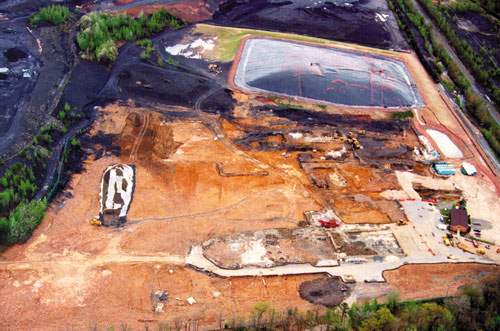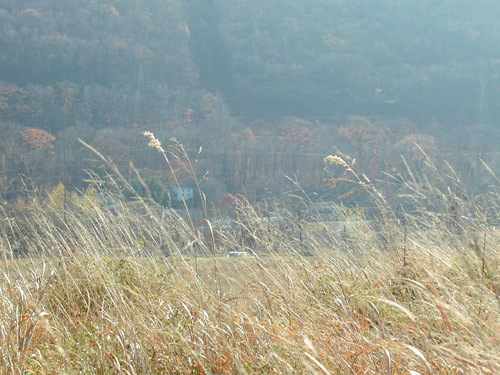
Panorama view of Treatment area at the Tonolli Metal site at the end of second growing season.
Introduction
In Fiscal Year 1999, more than 1,400 Superfund sites were listed on the National Priorities List. Of these, over 1,000 are actively being remediated or destined for completion. Many of these sites have soils contaminated with residual hydrocarbons. Historically, these soils have often been excavated and removed for landfill disposal off site. More recently, the trend is to remediate soils on site if technically and economically feasible. Conventional land treatment (CLT) bioremediation is often the preferred remedial option. It provides effective treatment, compliance with applicable, relevant and appropriate regulations, and is protective of underlying aquifers and the surrounding environment.
Within the past five years, bioremediation has been modified to include use of agronomic plants such as alfalfa (Medicago sativa), and more recently, native grasses. Phytoremediation occurs in petroleum-contaminated soils when use of plants enhances the rate of total petroleum hydrocarbon (TPH) biodegradation (Cunningham et al., 1996). If enhanced biodegradation does not occur, the term ‘plant-mediated bioremediation’ may be more appropriate. The advantages of using native species, long realized within the field of restoration ecology, are now being applied to phytoremediation.
Federal directives from President Clinton (Presidential Memorandum -26 April 1994; Presidential Executive Order 13112 on 3 February 1999) call for promoting native species in federally funded projects that involve revegetation and landscaping. In all Superfund projects, beneficial site reuse, known as Superfund’s Redevelopment Initiative (SRI), is strongly encouraged. Through the SRI, sites are being used to create habitats, nature parks, bird sanctuaries, and similar ‘green’ areas. Use of native species in the final stage of bioremediation of petroleum-contaminated sites is a wise choice if final land use includes creation of ecologically diverse, aesthetically pleasing, natural habitats and recreational areas.
| The advantages of using native species, long realized within the field of restoration ecology, are now being applied to phytoremediation. |
Some form of soil pretreatment may be required for successful establishment of native, warm-season grasses. We tested the warm-season native grasses big bluestem (Andropogon gerardii), little bluestem (Schizachyarium scoparium), switchgrass (Panicum virgatum), and Indiangrass (Sorghastrum nutans) in soil containing 2.3% slightly weathered crude oil from Kentucky. Although plants germinated well, their growth over a 60-day period was severely inhibited. But when soil was pretreated to slightly less than one percent TPH by bioremediation, growth was comparable to that in uncontaminated background soil.
Barnes (1999) documented substantial ecosystem benefits of warm-season bunchgrasses, along with associated legumes and wildflowers. These include food and cover for wildlife, high quality hay for livestock, and enhanced aesthetic values. No fertilization is required for their establishment, and they are very drought tolerant. Bunchgrasses have unique benefits for wildlife. Their bunch type growth characteristic with bare soil in between provides ideal nesting sites for birds and small mammals, and allows free movement searching for seeds, catching insects and dusting. Interspersed bare soil also permits encroachment of other plants, adding to biodiversity. These grasses also provide excellent winter cover for birds and small mammals.
Restoration of petroleum-contaminated sites includes both remediation and revegetation. In a previous paper, we reported on use of the Phased Approach for site restoration (Brown and Nadeau, 2000). Phase I consists of pretreatment using either CLT bioremediation, or plant-mediated treatment with petroleum tolerant plants, not necessarily native species. Phase II combines treatment with revegetation using low-maintenance native grasses. The Phased Approach was used at the Tonolli Metals Superfund site in Pennsylvania where we are testing both native and non-native plants for evidence of enhanced treatment.

Aerial View of the Tonolli Metals Superfund site with stockpiled petroleum contanimated soil on left.
Site Description
The Tonolli Metals Superfund site contained soil contaminated with highly weathered #4 fuel oil. At 3,800 ppm, the soil TPH level was low enough to directly implement Phase II of the Phased Approach without Phase I pretreatment. The goal is to achieve site restoration by combining plant-mediated bioremediation with revegetation using native, warm-season grasses by using the Phased Approach. Native warm-season grasses develop slowly, often requiring two to three years to fully develop. Because of this, non-competitive cool-season species were added as a nurse crop. Stockpiled soil was screened to exclude stone, amended with 2% spent mushroom compost (dry wt. basis) and 38.5 tons of lime and spread over 1.3 hectares to a depth of 15 cm. No fertilizer was added in the first year to discourage competition between the plants and microbes. At the outset of the second growing season, 128 lbs. of nitrogen was added to the site in the form of DAP. The site was planted in late May 1999, but required replanting in September due to a severe summer drought. The cool-season grasses and the birdsfoot trefoil were selected as nurse plants for late developing, native, warm-season bunch grasses. One year after planting, both cool and warm, season grasses were developing normally. Mowing of cool-season plants was conducted three times in 2000 to alleviate shading of developing warm-season grasses. In the spring of 2001, heavy growth of birdsfoot trefoil was controlled by application of 2,4-D, to encourage the second-year growth of underlying warm-season grasses.
| The Phased Approach was used at the Tonolli Metals Superfund site in Pennsylvania where we are testing both native and non-native plants for evidence of enhanced treatment. |
Hydroseeding and cultipacking were used for plant stand establishment and the resulting plant stand was very uneven. A more uniform plant population could have been obtained by drill seeding. An ideal stand of cool- and warm-season grasses should be somewhat sparse the first year, but with sufficient plant cover to prevent soil erosion. Such a stand would require little or no mowing the first year, and would alleviate competition with slower developing warm-season grasses.
Bioremediation effectiveness was monitored for two seasons using soil TPHs normalized to a degradation resistant hydrocarbon group (hopanes). When vegetation was established, vegetated and non vegetated plots were constructed to monitor the effect of vegetation on loss of TPHs. Nine plots each were selected for both vegetated and non vegetated treatments using a combined random/judgment approach. Soil fertility was comparable in both treatments. Two years after replanting, both cool- and warm-season grasses have developed normally, with no evidence of inhibited growth from petroleum hydrocarbons. Growth inhibition was not expected because initial soil TPH levels were well below one percent.
What we have learned thus far
Vegetated vs Non vegetated plots
A recent study by Kulakow et al., (2001) screened 29 plants for tolerance to 2.5% weathered soil TPHs over a 180-day period. They did not find evidence of plant-enhanced bioremediation, but suggested enhanced treatment may require a longer study. At the Tonolli site, we observed significant degradation (P= .05) in the hydrocarbon content of the soils in all the treatment cells except one. However, there has been no evidence of enhanced treatment in vegetated plots compared to the non vegetated plots after two growing seasons. We plan to monitor these plots for several more growing seasons. Enhanced biodegradation of recalcitrant hydrocarbons may require a mature rhizosphere, where products of root decomposition serve as substrates for cometabolism.
Planting Changes
We have not realized our goal of having complete stands of warm season grasses after two seasons. We underestimated the aggressiveness of the birdsfoot trefoil and the annual ryegrass which did re-seed itself after the first year. Although the birdsfoot trefoil may have retarded the development of the warm season grasses, the dense vegetative mats remaining from the luxurious growth of the birdsfoot trefoil served as superb cover and food supply for small mammal populations as evidenced from the network of trails, tunnels and droppings under the mats.
In retrospect, we would use a native legume, probably bush clover, tick trefoil, or partridge pea, and lower the seeding rate of the annual ryegrass to four lb./acre or less or even consider a less competitive annual nurse crop such as oats or wheat.

Mixed stand of switchgrass, annual rye and birdsfoot trefoil in Treatment Cell 3 at end of second growing season. October 2001.
Cost Savings
Cunningham et al., (1996) estimated the general cost of phytoremediation at $17 to $100 per m3; with the higher figure attributed to the cost of monitoring required by the client or regulatory oversight agencies. For the Tonolli project, the original amount of contaminated soil before removal of the > 4 inch cobble was estimated to be 5000 cu. yd. Transportation and disposal at a regulated landfill after chemical characterization of these soils would have cost approximately $500,000 (5000 cu. yd ~ 9000 tons at $45.00 per ton) Being that Tonolli is a Superfund Responsible Party Cleanup site, the responsible parties did not have to provide a breakdown of the costs associated with cobble removal, treatment cell preparation and amendment materials. We know that these costs were less than the $500,000 estimated to have the soils transported and disposed of off site. The monitoring cost for the project period thus far including the analytical chemistry is estimated to be $35,000.
Using Cunningham’s cost estimates and the original soil volume treated, and we estimate that the Tonolli costs are close to the high end of the range but less than the estimated transportation and off site disposal costs.
| There are obvious reasons for using native species for revegetating Superfund sites above and beyond phyoremediation purposes. Ecologically, the advantages of using native plants for site restoration are straightforward. |
Bottom line
There are obvious reasons for using native species for revegetating Superfund sites above and beyond phytoremediation purposes. Ecologically, the advantages of using native plants for site restoration are straightforward. Native species can be selected that are locally adapted, tolerant of soil drainage, salinity and other edaphic factors. They are aesthetically pleasing, beneficial to wildlife, and can become self-sustaining. These benefits are substantial, whether or not native species provide enhanced treatment of petroleum hydrocarbons. With appropriate management, an area once an industrial eyesore can be transformed into a healthy ecological habitat, a positive gain against the overall losses of such habitats in our nation’s landscape. L&W
For more information, contact Royal J. Nadeau, The Eco-Strategies Group, Box 433 Allamuchy, New Jersey 07820. email royal@theeco-strategiesgroup.com
References
Barnes, T. G. 1999. Establishing native warm season grasses for wildlife. Land and Water. Sept/Oct. pp. 43-46.
Brown, J. L. and Nadeau, R. J. 2000. A phased approach to bioremediation of petroleum contaminated soil using phytoremediation. 16 Intern. Conf. on Contaminated Soils, Sediments and Water. Univ. of MA, Amherst, MA. Oct. 16-19.
Cunningham, S. D., Anderson, T. A., Schwab, A. P., and Hsu, F.C. 1996. Phytoremediation of soils contaminated with organic pollutants. Advances in Agronomy 56:56-114.
Kulakow, P. A., Schwab, A. P., and Banks, M. K. 2000. Screening plant species for growth on weathered, petroleum hydrocarbon-contaminated sediments. Int. J. of Phytoremediation. 2 (4):297-317.
|
